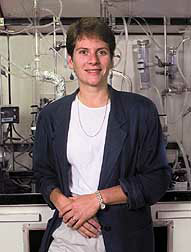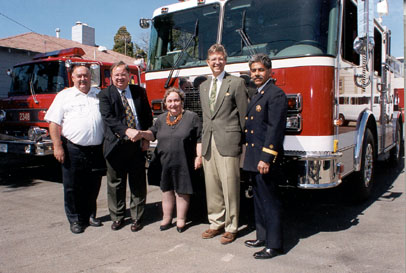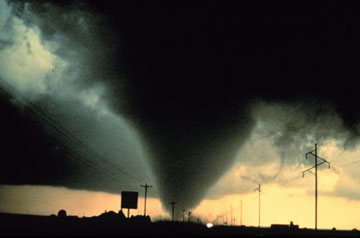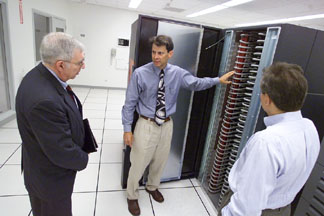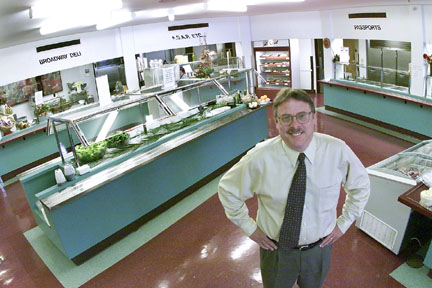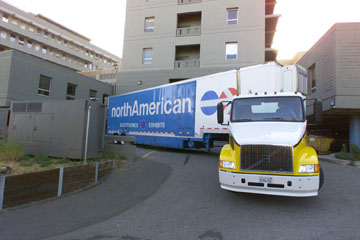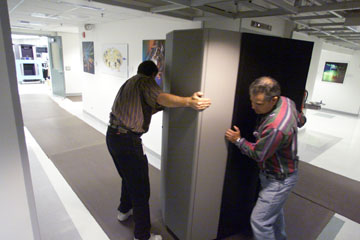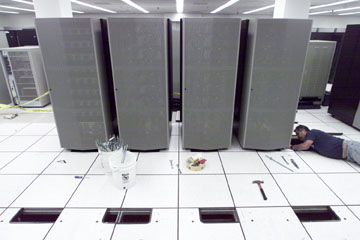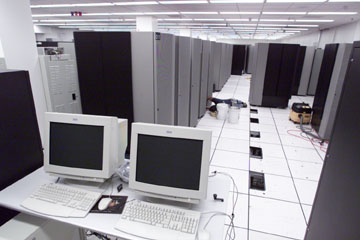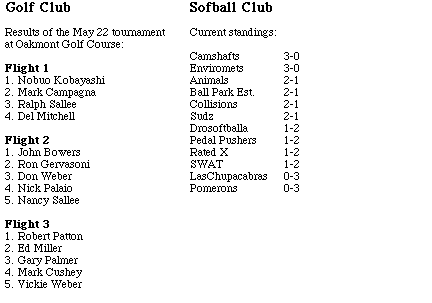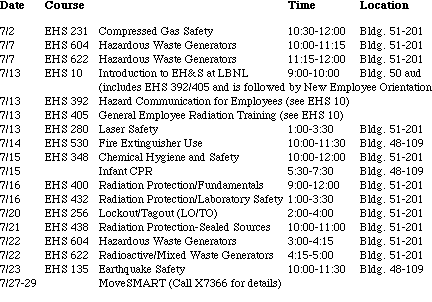
| Carolyn Bertozzi Wins MacArthur Fellowship |
Fire Aid Pact with City of Berkeley |
- Climate Modeling Sheds Light on Nature's Fury
- Washington Report
- White House Science Advisor Visits Berkeley Lab
- UC Under Fire for Security Lapses
- NRC Wants More Info on Yucca Mountain
- Berkeley Lab Currents
- Ardith Kenney Remembered as A True Computing Pioneer
- Lab's New Cafeteria Manager: Better Communication and More Fish
- NERSC's New Machines Roll In
- Y2K Team Confident of Business as Usual Come Jan. 1
- Currents Online
- Bulletin Board (Announcements and Events)
- Calendar of Events
- Advisory on Mixing Compressed Gases
- July EH&S Classes
- Earth Sciences Division Seminar
- Flea Market
- Flea Market Ad Policy
Carolyn Bertozzi Wins MacArthur Fellowship
By Paul Preuss
Carolyn Bertozzi, a member of the Biomolecular Materials Program in the Materials Sciences Division, has been named a MacArthur Fellow for 1999 -- one of 32 individuals across the country to receive this prestigious award. Bertozzi is also an associate professor of chemistry at UC Berkeley.The John D. and Catherine T. MacArthur Foundation awards the fellowships annually to "the most creative individuals" in all fields of endeavor, based not on applications or recommendations, but upon the advice of 100 anonymous "talent scouts" -- some of whom have clearly been on the prowl in the Bay Area recently, since Bertozzi is one of three people at UC Berkeley and one at Stanford to be named this year.
The fellowships, known in the popular press as "genius awards," carry a no-strings-attached, five-year stipend, the amount of which increases with the age of the recipient. At only 32, Ber-tozzi will have to make do with $255,000, which she plans to use to encourage secondary-school students interested in chemistry.
Carolyn Bertozzi
According to a front page story in the San Francisco Chronicle, when Bertozzi heard the MacArthur Foundation was trying to reach her, she thought "they're probably trying to get a hold of me for a quote about my sister" -- that's Andrea, a math professor at Duke University whom Carolyn regarded as "the smarter one in the family." When she learned she was the recipient, she said, "My first reaction was they got the wrong Bertozzi."
The right Bertozzi was indeed named Carolyn. She got her B.A. from Harvard in 1988 and her Ph.D. from UC Berkeley in 1993. Three years ago she joined Berkeley Lab and UC Berkeley after research stints at Massachusetts General Hospital and AT&T Bell Laboratories, with postdoctoral work at the University of California at San Francisco.
In one important line of research, she and her colleagues have found a way to engineer sugar markers on cell surfaces. These can control cell adhesion to materials used in biomedical implants and in the walls of bioreactors, and to electronic devices that could warn of environmental toxins. Cell-surface engineering has also been used to tag cancer cells for diagnostic probes and targeted drugs. In other projects, she and her colleagues have developed new organic materials for contact lenses and bone implants.
Bertozzi emphasizes Berkeley Lab's importance to her research, "which would have been quite different if not for my colleagues in the Materials Sciences Division," she says. "The people there focus on collaborative research across many disciplines. That is a key to encouraging creative thinking -- which is what the MacArthur Fellowships are intended to recognize." Bertozzi credits Mark Alper, head of the Materials Sciences Division's Molecular Biomaterials Program, as an experienced and dynamic mentor "who is always bringing intriguing new applications to my attention."
On behalf of the division, Alper says, "We were pleased to hear of Carolyn's award, although we are not at all surprised. She is one of our bright new stars. She is an outstanding scientist, with great creativity and imagination, an exceptional teacher, and a good citizen, always doing her share."
To learn more about Bertozzi's research, see http://www.lbl.gov/Science-Articles/Archive/custom-cells.html or visit Bertozzi's web page at http://www.cchem.berkeley.edu/~crbgrp/.
Fire Aid Pact with City of Berkeley
By Ron Kolb
With the wildland fire season about to begin, Berkeley Mayor Shirley Dean said her city's new emergency aid agreement with Berkeley Lab couldn't come at a better time.
Dean, City Manager James Keene and Berkeley fire officials joined hands on June 17 with Laboratory Director Charles Shank and the Lab's emergency response team to commemorate a historic pact that will provide the most efficient fire and safety services to the hills communities.
Shank and Keene signed a memorandum of understanding (MOU) which says that the Laboratory's fire department will provide first-response service within specific boundaries where it has been determined the Lab can arrive faster than the City due to unique access or physical proximity.
The City fire department will respond automatically to Laboratory calls for assistance in emergencies which exceed Berkeley Lab response capabilities or occur when Lab fire department personnel are off-site on other duties. The City will also make its training facility available to Berkeley Lab fire fighters at no cost, and joint training exercises will be conducted to maintain efficient interdepartmental coordination.
"This collaborative agreement represents a win-win solution for everyone," said Shank. "Our Berkeley Lab employees and our neighbors in the surrounding communities will be receiving the most responsive services to ensure their safety and security."
Referring to negotiations that lasted more than two years, Shank told the audience, which included City Council members Polly Armstrong, Betty Olds and Diane Wooley, that everyone can stop looking for the light at the end of the tunnel. "This is it," he said.
"We are committed to providing effective emergency response services," said Keene. "This agreement adds more capability to our existing system -- a real benefit to all."
Mayor Dean thanked fire chiefs Reg Garcia of Berkeley and Stacy Cox of the Laboratory for leading the efforts to complete the MOU. "We've had such an awful experience with wildfires," she said. "It is comforting to know that there's a fire department on that [eastern] side of the Hayward Fault that will serve the city."
The boundary within which Berkeley Lab will provide automatic aid to the city begins at the corner of Shasta Road and Golf Course Drive. The northern boundary proceeds west in an essentially straight line to Euclid Street, south to Bancroft Way, east to College Avenue, south to Dwight Way, east to Warring Street, south to Derby, and east towards the Berkeley/Oakland city limits.
Laboratory fire fighters will also be "first-in" to service two University of California campus buildings housing Berkeley Lab employees: Donner and Calvin Labs. Campus facilities -- including the Greek Theatre, Foothill Housing, buildings along the west side of Gayley Road (including Stanley Hall, Latimer Hall, Girton Hall, the Hass School of Business, Boalt Hall and Simon Tower), the Lawrence Hall of Science, the UC Botanical Gardens, Space Sciences Laboratory, Animal Behavior Research Station, and the Mathematical Sciences Research Institute -- will also be subject to Berkeley Lab's automatic response.
The City of Berkeley and the Laboratory initiated discussions in response to concerns expressed by Berkeley citizens about the safety of the surrounding hills communities. The talks focused on exploring options for mutual assistance within current staffing levels. The new interagency aid agreement emerged from those discussions.
Prior to the MOU, Berkeley Lab served the city in a "mutual aid" capacity, responding to emergency calls if assistance was requested.
The district responsibility lines were drawn on the basis of quickest response time from either Laboratory or City fire stations. Outside the Berkeley Lab response zone, mutual aid will be in effect -- that is, Laboratory personnel will respond to assist Berkeley City fire fighters if requested and able.
Among those from Berkeley Lab playing key roles in forging the agreement were fire chief Cox, health and safety specialist Jeffery Chung, attorney Glenn Woods, Laboratory emergency services manager Don Bell, Environmental Health and Safety Division Director David McGraw, and Deputy Director Klaus Berkner.
The contract is effective until terminated by either agency with a 30-day advance notice.
The key players in the fire aid agreement between Berkeley Lab and the City of Berkeley: Lab Fire Chief Stacy Cox, Director Charles Shank, Berkeley Mayor Shirley Dean, City Manager James Keen, and Berkeley City Fire Chief Reg Garcia. Photo by Don Fike Climate Modeling Sheds Light on Nature's Fury
By Paul Preuss
In the first week of May tornadoes hit Kansas and Oklahoma in one of the most destructive outbreaks in recorded weather history. During the same month, a new world record for annual snow accumulation was reported on Oregon's Mount Hood. Yet the 1990s have been reported as the warmest consecutive years in 150 years of climate record keeping.
Recently climatologists have seen an increase in extreme weather worldwide, including heavy precipitation, flooding and extended drought -- some of the most unusual weather patterns since weather and climate data collection began. Is this natural climate variability, or is it climate change? Or possibly some combination of the two? The answer is not yet clear.
Working to understand these phenomena and provide communities with weather and climate information, scientists process a flood of data from numerous sources of observation: on the ground, from satellites in orbit, and increasingly, from computer simulations.
This year has seen unusually destructive weather, such as devastating tornadoes in Kansas and Oklahoma. Photo by: National Oceanic and Atmospheric Administration
"People have been developing GCMs (global climate models) since the late sixties," says Norman Miller, leader of the Regional Climate Center in Berkeley Lab's Earth Sciences Division. "But GCMs, which link global atmospheric and oceanic circulation models, run at fairly coarse resolution. For example, a global climate model may detect the Rocky Mountains as a single upslope from the Pacific and a downslope to the Midwest, missing the Coastal Ranges and the Sierra mountains altogether."While models with resolution at too fine a scale can overwhelm even state-of-the-art supercomputers, Miller says, "our Regional Climate System Model downscales GCMs and other global-scale information to simulate events on the local scale more accurately, such as the danger of flooding in a particular river valley."
The Regional Climate Center's ultimate goal is accurate prediction at spatial scales that vary from less than 100 meters to as big as the western United States, and at time scales ranging from hours to seasons to a century or more. While this ambitious goal is a long way off, computational tools such as the Regional Climate System Model (RCSM), pioneered by Miller and Jinwon Kim, have already achieved notable successes.
During the winter of 1994-1995, while Miller and Kim ran an early version of the RCSM over the California-Nevada region and on two Northern California watersheds (the Russian River and the North Fork of the American River), a series of intense storms moved over California and the Southwest. Miller and Kim's initial system linked an atmospheric model, a soil-plant-snow model, and a hydrology-riverflow model to produce simulated predictions of local precipitation and river flow; then they compared the resulting simulations against real events.
In the case of the Russian River, the hydrology model was able to accurately predict the river's disastrous flooding in early January and March of 1995 -- two days in advance. On the North Fork of the American River, no historical data was available in 1995 to fully calibrate and verify the hydrologic model; still, Miller and Kim were able to simulate the relative response of the river's flow during the spring snow melt.
The RCSM's predictive capability was demonstrated again, and with improved accuracy, during flooding in California in January 1997. In addition to 48-hour forecasts, new seasonal predictions were obtained during the El Niño winter, firmly establishing the Regional Climate Center's approach to predicting local water resources and weather impacts by linking global climate models to the RCSM.
Then, in January of 1999, the California Water Resources Research and Applications Center was inaugurated. Sponsored by NASA, this center brings together investigators from UC Berkeley and UC Santa Barbara, who work with Berkeley Lab's Regional Climate Center in partnership with state and federal agencies. Using satellites and other data sources, the new center will produce snow-runoff and river forecasting, sediment transport modeling, and tracking of landslide and wildfire risks. Among the users will be institutions and individuals with a stake in agriculture, forestry, the environment, insurance, and emergency response.
The Regional Climate Center links numerous universities, public and private institutions, and agencies of state and local governments, which provide data to the center and use its output. The center works with over a dozen collaborating groups in the United States and with agencies in Australia, Korea and China.
"We work as a synergistic group of centers," says Miller, "sort of a big web with lots of complementary nodes."
The power of massively parallel computers at the National Energy Research Scientific Computing Center (NERSC) is crucial to refining the spatial resolution of the RCSM and increasing its usefulness. Working on the Cray T3E under a NERSC grant, the Regional Climate Center has completed an initial study of the long-term effects of increased atmospheric carbon dioxide on the climate of the western United States. NERSC's new IBM RS/6000 will provide an even more powerful means of bringing climate simulations down to earth, making it possible to model the entire continental U.S. at a resolution below 36 kilometers.
According to Miller, there are signs that the climate is indeed changing. "Increased heating of the lower atmosphere is generally accepted by the scientific community; the increased atmospheric energetics and the ability to hold more water in the lower atmosphere may lead to more extreme weather events occurring more often."
Specific weather events, however -- such as the recent, historically destructive tornadoes in the Great Plains -- cannot be ascribed to climate change directly, Miller says. But he would not be surprised to see an increase in unusually powerful storms in the future.
The Department of Energy's Office of Science is emphasizing the vital importance of climate models, accurate prediction, and useful information accessible to local communities through its Accelerated Climate Prediction Initiative. Berkeley Lab's Regional Climate Center is already demonstrating that the job can be done. To find out more, visit their web site at http://ccs.lbl.gov/ RCSM/.
White House Science Advisor Visits Berkeley Lab
Artie Bienenstock (left), the associate director for science in the White House Office of Science and Technology Policy, gets a demonstration of NERSC's computer capabilities from Computing Sciences head Bill McCurdy. Bienenstock visited Berkeley Lab recently to meet with Lab management and scientists and tour research facilities. Photo by Roy Kaltschmidt.
Washington Report
DOE Issues Reforms to Improve Construction Management
D
eputy Energy Secretary T.J. Glauthier has released a set of reforms to improve the management of construction projects at DOE's national laboratories. The reforms include a project management tracking and control system for all projects worth at least $20 million; a "chief operating officer's watch list," including projects with "significant issues or emerging problems"; and the assignment of specific project-management personnel within each major program at the department.Glauthier praised the B-Factory, the Advanced Photon Source, and the Relativistic Heavy Ion Collider as "outstanding examples" of construction management, but acknowledged that other DOE-funded projects "have been managed poorly." He said independent external reviews have indicated "serious systemic issues needing correction."
"Among the most prevalent problems," Glauthier said, "are inadequacies in technical scope, schedule planning and control, cost estimating and lack of clarity on roles and responsibilities."
DOE Certifies Oak Ridge as Best Location for SNS
A
favorable "record of decision" for the Spallation Neutron Source at Oak Ridge National Laboratory has been issued by the Department of Energy, confirming the department's belief that ORNL is the best location for the $1.3-billion facility."This completes another step on the path to making a world-class facility available for the research of the next century," Energy Secretary Bill Richardson said.
The record of decision is the final action in the department's environmental impact statement process for the facility, which is the site of a collaborative project between ORNL, Berkeley Lab, and the national laboratories at Brookhaven, Argonne and Los Alamos.
In its decision the DOE cited environmental considerations and the presence of ORNL's High Flux Isotope Reactor (HFIR), which is used for cold neutron scattering research, as reasons for locating the SNS in Tennessee.
"The combination of HFIR and SNS will provide the full spectrum of neutron research tools at one laboratory, thus allowing scientists to optimize on-site research during their time at ORNL," the record of decision said.
This record is available on the Internet at http://tis.eh.doe.gov/ nepa.-- Lynn Yarris
UC Under Fire for Security Lapses
S
everal members of the House Commerce Committee, including its ranking Democrat, John Dingell of Michigan, have suggested that the Department of Energy dismiss the University of California as manager of the weapons labs at Livermore and Los Alamos. The suggestion comes because of allegations that lax security contributed to foreign espionage at those facilities.Criticism of UC management of the weapons labs is likely to be further fed by the findings of a security oversight team commissioned by the DOE. The news media is reporting that the team uncovered "critical weaknesses in computer security, protection of nuclear materials, and reaction capabilities" of the guard force at Livermore.
The DOE investigative team was assembled by Secretary of Energy Bill Richardson in response to the spying allegations.
In response to the Congressional criticisms, Secretary Richardson said that he will consider seeking new offers on Los Alamos and Livermore management when the UC contracts expire in 2002, just as he has done when DOE's agreements with other lab contractors have run out. He also said UC's handling of security will be just one factor in that decision.
Richardson has been adamant that DOE shares the blame with UC for inadequate security at the labs. Security, however, is improving, he claims.
"Los Alamos and Lawrence Livermore felt they were these independent operators and they didn't have to answer to anybody," the Secretary said. "And that has changed."
UC came under additional criticism when the General Accounting Office released a report that suggested Congress eliminate a provision in the Price-Anderson Act exempting nonprofit contractors from paying penalties when they commit safety violations.
The report also recommended that the DOE strengthen the department's nuclear safety enforcement program and make sure its field offices are consistent in applying the program.
Status reports on safety and security at Los Alamos and Livermore in FY98, prepared by DOE's operations offices in Oakland and Albuquerque, gave UC grades in the 70s, which the offices consider "good." UC's performances in other areas of management received grades in the 80s and 90s, either "excellent" or "outstanding."
UC officials have expressed confidence that grades for safeguards and security will improve in FY99, when the DOE offices compile that report later this year.-- Lynn Yarris
NRC Wants More Info on Yucca Mountain
In a review of DOE's viability assessment of Yucca Mountain, the proposed site for a permanent nuclear waste repository, the Nuclear Regulatory Commission listed five areas for which it says more information is needed: repository design, waste package corrosion, quantity and chemistry of water contacting waste packages and waste forms, saturated zone flow and transport of radioactive materials, volcanic disruption of the waste package, and quality assurance of all safety systems.
Berkeley Lab researchers in the Earth Sciences Division have been major contributors to computer models of the Yucca Mountain site. Copies of the NRC review of the viability assessment are available on the Internet at http://www.nrc.gov/OPA/reports/va.htm.
Berkeley Lab Currents
Published twice a month by the Public Information Department for the employees and retirees of Ernest Orlando Lawrence Berkeley National Laboratory. Ron Kolb, PID department head.
EDITOR: Monica Friedlander, (510) 495-2248, msfriedlander@lbl.gov
STAFF WRITERS: Paul Preuss, 486-6249; Lynn Yarris, 486-5375
CONTRIBUTING WRITERS: Jon Bashor, 486-5849; Allan Chen, 486-4210; Jeffery Kahn, 486-4019
FLEA MARKET / CALENDAR: Jacqueline Noble, 486-5771
fleamarket@lbl.gov / currents_calendar@lbl.govPublic Information Department, Berkeley Lab, MS 65A
One Cyclotron Road, Berkeley CA 94720
Tel: 510/486-5771 Fax: 510/486-6641
Berkeley Lab is managed by the University of California for the U.S. Department of Energy.
Ardith Kenney Remembered as A True Computing Pioneer
By Blake Likins
A
rdith Shearon Kenney, one of Berkeley Lab's original programmers, died on June 7 at the age of 75.Kenney came to what was then the Radiation Laboratory as a mathematician doing hand computing back in 1949. Victor Brady, one of Kenney's colleagues at the time, remembers the early days of working with Kenney. When physicists needed calculations done, he says, they would come to the close-knit group of a half dozen "computers," the name given to the first programmers, who would use electromechanical Marchant calculators to literally crank out answers. The team would sit down together for weeks to solve differential equations by hand.
When the first digital computing machines were introduced at the Lab, human computers like Kenney and Brady had to figure out how to program them.
"When Ardith started on computers, everything you did once you had loaded in the cards was controlled by decimal, ten-digit commands," recalls computer scientist Marjory Simmons, a long-time friend and colleague of Kenney's.
"All this within a computer memory comprised of a mighty 2,000 10-digit cells: no FORTRAN, no disks, no magnetic tapes, no video display terminals."
When Ardith Kenney returned to the Lab in 1957 after taking some time off to have a son, she became one of the first programmers hired for the Laboratory's new IBM 650. She continued to work on increasingly larger computers, and many of the original codes written at the Lab would help lay the foundation for the future of programming.
The work of Kenney and her peers was instrumental to the success of numerous projects at the Lab. The calculations she worked on contributed to the work of Nobel laureates Owen Chamberlain, Emilio Segrè and Luis Alvarez, among many others.
Kenney also worked as a consultant for Fermi and Brookhaven National Laboratories, where she worked on the accelerator design program SYNCH. She retired in 1983.
Friends remember Kenney as a caring, compassionate woman, who was very close to her son Brian. Simmons reflected on some of the things that Kenney loved most, particularly big band music, theatre, martinis, dogs and, "most of all, congenial human company, of which she was the best example."
A memorial service for Kenney will be held in Berkeley on Saturday, July 17, from 4:00 to 7:00 p.m. For additional information call 524-1861.
***
Blake Likins is a summer intern from UC Berkeley who works in the Public Information Department.
Lab's New Cafeteria Manager: Better Communication and More Fish
By Blake Likins
S ince last month Berkeley Lab has a new cafeteria manager. Replacing Mark Blum is Peter Demarest, who has worked in the restaurant business since 1976 and now plans to make use of his long experience and creativity -- as well as new culinary-schooled chefs -- to improve the Lab dining experience.
His goal, Demarest says, is to move toward more creative and less repetitive menus than have been used in the past. Already he has begun featuring three different specials every day, and plans to rotate the menu roughly every 90 days instead of monthly. A few favorite dishes, however, such as the Fiesta Salad and Pasta Piatti, will continue to be featured on a more regular basis.
Demarest also pointed out the challenge of serving the Lab's ethnically diverse population, and he aims to find a combination of fresh and inventive foods to suit everyone's taste.
Moreover, Demarest would like to see a constant dialogue between his customers and the dining staff. "I'm trying to open up communication," he says. "I love to meet everyone and want to build the kind of rapport we should have with all Lab employees." To this end he also plans to meet with department heads once a month and encourages everyone to provide feedback and ideas. Employees may do so by e-mailing him via the cafeteria's web page (http://www.lbl.gov/Workplace/cafeteria/) or by using the suggestion box near the entrance of the dining hall.
After more than 10 years at Spenger's Fish Grotto in Berkeley -- at its peak, one of the top-10 highest grossing restaurants in the United States -- Demarest is looking forward to the change of pace and plans to spend more time with his wife and daughter.
As for what he hopes to bring to the Lab cafeteriafter all his time at Spenger's, he replied with enthusiasm, "more fish!"
***
Blake Likins is a summer intern from UC Berkeley who works in the Public Information Department.
Peter Demarest, former general manager at Spenger's Fish Grotto NERSC's New Machines Roll In
NERSC's latest procurement of supercomputers -- 35,603 pounds of machines -- rolled into Berkeley Lab early last Saturday, nearly filling three giant vans. The crew of North American Van Lines, IBM and NERSC staffers unloaded the equipment in the loading area of Bldg. 50 and then moved the machines to their new home on the first-floor machine room in Bldg. 50B. This shipment represents Phase 1 of the NERSC-3 procurement, which boasts a total of 512 processors and a peak performance of 410 billion calculations per second. Photos by Roy Kaltschmidt
Y2K Team Confident of Business as Usual Come Jan. 1
By Jon Bashor
Paychecks will be issued, Lab emergency services will still be dispatched and programmatic funds will still be disbursed come Jan. 1, 2000, Lab employees were assured at a recent brown-bag forum on Y2K issues.
In discussing the labwide assessment and testing for potential Y2K problems, the Berkeley Lab team charged with smoothing the computer-related transition to the year 2000 predicted a pretty uneventful New Year's observance, but have made contingency plans just in case the path gets bumpy. Extra staff will be on hand at the Lab to welcome the new year and handle any glitches as they arise.
The possible problems, which have led some to predict doomsday scenarios, stem from the inability of older computer systems to differentiate the year 2000 from the year 1900. In the worst cases, computers will crash and could take essential services with them. Only recently have computer systems been designed to accommodate four-digit years.
"Because we saved 12 bits in 1965, we're being forced to spend millions and millions of dollars in 1999," said David Stevens, head of the Lab's Y2K team. "It's a real problem, but not catastrophic. We basically think the world is in pretty good shape."
At the June 23 forum, Carl Eben, head of the Lab's Information Systems and Services Department, said that all 14 core computer-based administrative systems have been tested and either certified as Y2K compliant or will be replaced by new systems before the end of the year.
These systems range from Accounts Payable to Work for Others, and include Human Resources/Payroll and LETS. Using a dedicated computer, Eben's department has extensively tested all the systems, including the last 1999 biweekly payroll period, which will start in December and end in January, and tested the system with the Bank of America and the national clearinghouse responsible for direct deposits of paychecks.
"We feel extremely confident about our systems," Eben said, "but even so we have made backup plans to make sure everything goes smoothly."
Mark Turner of the EH&S Property Protection & Life Safety Group told the audience that the group will be well-staffed and prepared during the Y2K rollover. Although confidence is strong that active systems will continue service, a full shift of fire fighters and extra security staff will be on hand to address potential health, safety and security issues from unforseen breakdowns.
This staffing is similar to that already maintained 24 hours each day. Even the Lab's new Master Emergency Plan has a section on Y2K recovery, Turner said.
The Lab's contingency response team has benefitted from a previous "business recovery" emergency exercise, and another exercise is planned for this fall.
The Lab's team has the important advantage of knowing when a potential Y2K contingency may be needed due to is its georgaphical location on the West Coast. Because of the time difference, the Y2K team will be able to observe the effects of Y2K on other parts of the country and the world before they occur here, Stevens noted.
In addition, the reduced labwide staffing during the holiday shutdown will diminish the risk to employees.
Deputy Director Klaus Berkner reviewed the Lab's participation in Y2K discussions with the city of Berkeley. The most likely problems, he said, will involve possible power outages, and the biggest factor in the severity of any problem is how people react, especially if they panic. City officials were also interested in how essential Lab systems would function, Berkner said.
Stevens said that the Lab has also been the subject of extensive review by the Department of Energy and has been audited internally and externally. Mission-critical systems, identified as NERSC and the Energy Sciences Network (ESnet), have been thoroughly tested and certified.
Employees are responsible for their own computer systems and should try to identify and test all desktop and embedded systems, Stevens said. And as a final gesture, they should turn off all nonessential computer systems before leaving on Dec. 23 for the holiday shutdown.
For reliable information, including rumors and responses, employees can visit various websites. Among those recommended by the Y2K team are:
- At Berkeley Lab: http://www.lbl. gov/ICSD/CIS/y2k.html
- The President's Council on Y2K Conversion: http://www.y2k.gov
- The U.S. Senate Special Committee on the Y2K Technology Problem: http://www.senate.gov/~y2k
Questions specific to Y2K issues may be directed to y2k@lbl.gov.
Currents Online
The full text and photographs of each edition of Currents are published online at http://www.lbl.gov/Publications/Currents/. You may find a link to Currents on the Lab's home page under the heading "Publications." The site allows users to do searches of past articles going back to 1994.
Bulletin Board
Community College Interns: A First for Berkeley Lab
Photo:Community college students from throughout California meet for orientation on the first day of an eight-week program that places them in various departments working in biotechnology, environmental science, and computing science. The program is part of a national community college initiative launched this year by the U.S. Department of Energy. Photos by Roy Kaltschmidt
Blood Drive on July 15 & 22
The next blood drive at Berkeley Lab is scheduled for consecutive Thursdays, July 15 and July 22, from 7 a.m. to 1 p.m. in Bldg. 70A, Room 3367.Donors are urged to make an appointment as soon as possible by calling X4009 in order to help organizers plan the event. The blood drive will benefit the Blood Bank of Alameda-Contra Costa Counties.
For more information or to register, contact Helane Carpenter at X4009 or mhcarpenter@ lbl.gov.
Web Tool Estimates Retirement Information
An expanded UC Retirement Plan "benefit estimator" is now available on the UC Bencom website at http://www. ucop.edu/bencom. This modeling program allows users to estimate benefit amounts -- including monthly retirement income, lump sum cash-out, survivor benefits, payment options, as well as the future value of the capital accumulation provision (CAP) account. The estimator also makes it easy for employees to compare different benefit scenarios and determine the best time to retire.To use the estimator, users need to enter some basic information, including date of birth, projected retirement date, UCRP service credit, and average monthly salary. The program calculates benefit estimates based solely on the information entered.
Sports Update
Proposal Kickoff for Technology Research Partnership Program
Proposals are being accepted for the new SC-LTR (Lab Technology Research) multiyear partnership projects to begin in FY2000. Each project will receive up to $750,000 in DOE funds over a three-year period, with up to $125,000 for FY2000. Industry partners will at least match the DOE funding. Preproposals are due to the Lab's Technology Transfer Department by Aug. 23.Two kickoff meetings to review the application process, including pre-proposal requirements, selection criteria, and funding availability, will be held on:
PIs, support staff, and others wishing to prepare for a future industry-Lab partnership project are invited to attend one of these sessions.
- July 8, 10:30 to 12:00, Bldg. 2-100B
- July 13, 2:00 to 3:30, Bldg. 2-100B
This is the start of a selection process which will conclude with the funding of about 15 multiyear projects. Last year Berkeley Lab won four of the 15 awards. For more information contact Chris Kniel in Tech Transfer at X5566, crkniel@lbl.gov.
UC Retains Major Medical Plan Providers
After a comprehensive 18-month evaluation, the University of California has selected the companies to offer medical coverage to UC employees, retirees, and their families beginning Jan. 1, 2000.Prudential will be retained for the UC Care, High Option, and Core plans, and Health Net, PacifiCare, and Kaiser will provide HMO coverage.
Additional details regarding the bidding process are available on the Bencom website at http://www.ucop.edu/bencom.
More information will be added soon in preparation for the open enrollment period in November.
Craft Fair Meeting
It's that time again: planning for Berkeley Lab's 1999 Holiday Craft Fair. The first meeting will be held on Monday, July 12, from 12:00 to 1:00 p.m. in the Bldg. 54-130B (cafeteria conference addition). Everyone who would like to participate in the planning process is invited. If you are unable to attend this meeting but wish to assist in the planning, contact Shelley Worsham at X6123.
Deadline Extended for Marine World Tickets; A's Tickets Sold Out
The deadline to purchase discount tickets for the Day at Marine World has been extended to July 14. You may contact Lisa Cordova at X5521 or buy the tickets in person during the lunch period every Wednesday in the cafeteria foyer.Please note that the tickets for the Aug. 8 Oakland A's game are already sold out.
Calendar of Events
The Berkeley Lab Calendar is published biweekly here on the World Wide Web and in Currents by the Public Information Department. Employees can list a meeting, class, or event in the Calendar by using this submission form. The deadline for submissions is 5 p.m. on Monday in the week that Currents is published.
In addition to the events listed below, Berkeley Lab's Washington, D.C. Projects office is hosting a Science and Technology Seminars series.
Scientific Conferences
General Interest
MON., JULY 5
INDEPENDENCE DAY HOLIDAY
THURS., JULY 8
INFORMATION SESSIONS FOR PURCHASING ELECTRONIC SUPPLIES
10:30 a.m. and 1:00 p.m. Bldg. 65 conference room
KICKOFF MEETING FOR TECHNOLOGY RESEARCH PROJECTS PROPOSAL
10:30 - 12:00, Bldg. 2-100BMON., JULY 12
CRAFT FAIR PLANNING MEETING
12:00 - 1:00, Bldg. 54-130BTUES., JULY 13
NEW EMPLOYEE ORIENTATION
Starts at 9:00, Bldg. 50 auditorium
KICKOFF MEETING FOR TECHNOLOGY RESEARCH PROJECTS PROPOSAL
10:30 to 12:00, Bldg. 2-100B
Items for the two calendars (General Interest and Lectures & Seminars) may be sent via e-mail to currents_calendar@ lbl.gov, faxed to X6641, or mailed to Bldg. 65B. The deadline for the July 16 issue is 5 p.m. Monday, July 12.
EH&S Safety Tip
Advisory on Mixing Compressed Gases
Given the inherent hazards involved in handling gases used in laboratory research, Berkeley Lab has well-established procedures for the purchase and use of various potentially dangerous gases. Recently EH&S has issued a specific advisory regarding the use of "custom mixtures," which involves the transferring of gases from one or more cylinders to another at high pressures -- known as "trans-filling."
To begin with, OSHA requires that the procedure be done only by a gas manufacturer using trained personnel with appropriate equipment and operational procedures.
Laboratory personnel should obtain custom gas mixtures only through approved sources. The Procurement Department has service agreements with two gas supply vendors -- Scott Specialty Gases and AirGas -- and all gas purchases should be done through them.
Trans-filling raises some serious safety issues, including:
Furthermore, all users of gases must be trained. At a minimum, Compressed Gas Safety (EHS 231) and Chemical Hygiene and Safety Training (EHS 348) are required. Online registration for these courses may be done at http://www-ehs.lbl.gov/html/training.htm.
- During the manual transfer of high-pressure gases tremendous amounts of stored energy can be released should any component failures and line ruptures occur. Ordinary fittings cannot withstand typical gas cylinder pressures of 1500 psi or more and could fail, resulting in the release of toxic gases.
- The gases being used have inherent hazards of their own and must be handled with extreme care. Silane, for example, is a pyrophoric gas (one that spontaneously ignites when exposed to air). A mishap during trans-filling could have had disastrous results.
- Waste disposal: Proper labeling of gases is critical. Makeshift labels can fall off the cylinders resulting in gases that are unidentifiable and must be disposed of as hazardous waste.
To properly handle, transport and dispose of the cylinders, they need be sampled and analyzed, something Berkeley Lab is not in a position to do. During a recent incident an external consultant had to be hired at high cost.The Laboratory's procedures for the purchase and use of toxic, pyrophoric, corrosive, and other hazardous gases, which must be approved by an EH&S industrial hygienist, is explained further online at http://Purch1. lbl.gov/lbnl/scott.htm.
Engineering controls, such as ventilation, gas detection and alarms systems, are explained in PUB 3000, Chapter 13, at http://ehssun.lbl.gov/ ehsdiv/pub3000/CH13.html.
For further information regarding pressure safety, the use of hazardous gases, or any special needs, contact John Seabury of EH&S at X6547.
July EH&S Classes
To enroll contact Susan Aberg at Saberg@lbl.gov or register via the web: http://www-ehs.lbl.gov/ehstraining/registration/. Preregistration is required for all courses except EHS 10 (Introduction to EH&S). Times and locations are subject to change. Check the EH&S training website for updates to this schedule.
Earth Sciences Division Seminar
July 9, Friday
11 a.m., Bldg 90-2063
A Practical Particle Tracking Algorithm for Tracer Flow Simulation
Presented by Jianchun Liu of Earth Sciences
Flea Market
Autos / Supplies
`83 VOLVO sedan, 150K mi, auto, ac, runs well, $2,500/b.o., Ursula, X4338, 215-7617`83 VW Quantum stn wagon, 5 spd, runs very well, 130K mi, radio/cass, sunroof, $999/b.o., Wilk, 486-5942
`89 MAZDA, 929, 4 dr, auto, pwr str, pwr win, pwr lock, cc, ac, am/fm/cass, sun roof, white, 109K mi, exc cond, $4,200, Nora, 495-2439
`93 MERCURY Tracer stn wagon, auto, ac, am/fm/cass, new transmission, 4 new tires, new brakes, warranty till June 2000, just smog checked and registered, have all records, very good cond, $3,500/b.o., Federica, X6715, 524-2341
`94 FORD Mustang, silver color, 3.8 L, 65K mi, fully-loaded, ps, pb, ABS, pwr locks, pwr windows, pwr seat, air bags, CD/cass, ac, rear defroster, new tires, new transmission, just tuned up, runs exc, lots of power, $9,500, Lisa, X5314, (925) 906-9786
`97 TOYOTA Tacoma, 29K mi, 5 spd, 4 cyl, ac, am/fm, short bed, bedliner, $9,000, Monica, X5694
Housing
BERKELEY HILLS, room for rent in private home, Euclid and Cedar, 5 blocks from campus, fully furnished, kitchen privileges, washer/dryer, deck, w/ beautiful view of SF, Golden Gate and the bay, close to transportation and LBNL shuttle, shops, tennis courts, Rose Garden, non smoking, no pets, must be clean, prefer visiting scholar or full time working person, $550/mo + util, 841-2749BERKELEY, NORTH, share 2 bdrm, nr. BART, shopping, $400/mo + util, first/last/security, enjoy music and fitness, sense of humor a must, 15 mins from LBNL, Marcia, X6068, Harold, 527-3931
BERKELEY, apt, modern, furn, kitchen, 3 bdrm/2 bth, ww carpet, living rm w/ fireplace and vaulted ceilings, master bdrm w/ fireplace, master bath w/ jacuzzi tub, washer/drier, deck, off-street parking, nr downtown, $2,200/ mo, David, 525-4470
DANVILLE, 3 bdrm/2 bth house, large fenced yard, 2 car garage, avail July 1, walking distance to exc schools, $1,950, Jim, (925) 831-9958
PINOLE, 1 bdrm/1 bth in house w/ working female, cats and small dog, non-smoker/drinker, full kitchen/laundry privileges, $600/mo, incl util, cable TV, possible carpool to Lab, avail 8/1, Sue, X6661, 758-4164
Miscellaneous
BIKE, mtn, GT Zaskar, `96, fully XT-equipped, JudyXC, very good cond, new, $2,000, $800/b.o., Wilk, X5942CANOE, Coleman, 15 ft, good cond, 2 oars, life vests, $150, Rick, X7846
COUCH, sectional, 2 pieces, 2'x45", Danish modern, brown w/ lighter stripe, good cond, $75/b.o., Herb, 527-4441
EXERCISE MACHINE, Sears Lifestyler CardioFit, as-new, electronic monitor, complete w/ manual, $100/b.o., Ian, X4174, 548-7102
HARD DISK, 1.6 GB, IDE Quantum Fireball, works in PC's and some Macs, $25, H. Matis, X5031, 540-6718
HOUSE SITTING, staff scientist, July and half of Aug, mature, experienced, Steve, X6941
MOVING SALE: complete bed queen size (wooden platform, orthopedic mattress, 2 pillows, cover, $190/b.o.; futon, wood frame, queen size, $170/b.o.; dinette set (wooden table + 4 chairs), $110/ b.o., all items are like new, Federica, X6715, 524-2341
SERVICES, interior painting, free estimates, Rita, X5621, 465-3813
SHED, metal storage, 6'x10'x6' gd cond, $50; futon, dbl size, pine w/ southwest pastel color pad, $50, (925) 833-1668, X4319.
Wanted
COUCH/SOFABED, 72''- 78" in length, modern style preferred, Carmen, X4368GENERATOR, suitable for an RV, about 4K capability, needed to run ac, will consider a portable or permanent model, Jack, X6750
HOUSING for visiting Austrian scientist and family (wife and two young children), 2 to 3 bdrm, for one year beginning in Sept, Werner Grogger, f705grog@ mbox.tu-graz.ac
HOUSING for approx 5 mo beginning Sept 1 for visiting research student, looking for a not-too-expensive, furn single rm or small apt w/ cooking facilities, Hilma, X6050, hcjohnsen@ lbl.gov
HOUSING for visiting postdoc, 2 bdrm apt or house for at least 1 year starting Oct 1, Alina, cheral@math.tau.ac.il, Valerie, X5369
HOUSING, short-term, for visiting prof, 2-3 bdrm furn apt or house, 7/1 to 10/15, Raz, razk@math.huji.ac.il or Valerie, X5369
HOUSING in Berkeley, Kensington or Albany for assistant to emeritus physicist, short term starting Aug 1 (or longer if mutually agreeable), prefer in-law unit w/ separate entrance, references, Senta, 524-4654
HOUSING for LBNL employee, 3 bdrm, within 20 mins commute, 1-yr lease, beginning around Sept 1, Doug, X7141, 486-1411
HOUSING for visiting scientist, furn apt or rm for single woman, 7/17 to 9/15 or a part, can share, can cat/dog-sit, Ian, X4174, 548-7102, igbrown@ lbl.gov
PROJECTION GEAR, looking for Kodak projectors, lenses, dissolve units and screens, Dave, X7826, (925) 969-1379
SLIDE PROJECTOR, GAF or Sawyer brand, working order, Karl, X6129, 222-2338
Lost and Found
Found small amt of cash in the cafeteria by the utensils, 6/17, 11:30 to noon, Sharon, X5430Flea Market Ad Policy
Ads are accepted only from LBNL employees, retirees, and on-site DOE personnel. Only items of your own personal property may be offered for sale.
Submissions must include name, affiliation, extension, and home telephone number.
Ads must be submitted in writing--via e-mail (fleamarket@lbl.gov), fax (X6641), or delivered/ mailed to Bldg. 65B. No ads will be taken by phone.
Ads will run one issue only unless resubmitted in writing. They will be repeated only as space permits.
The deadline for the Jan. 15 issue is 5 p.m. Friday, Jan. 8.
